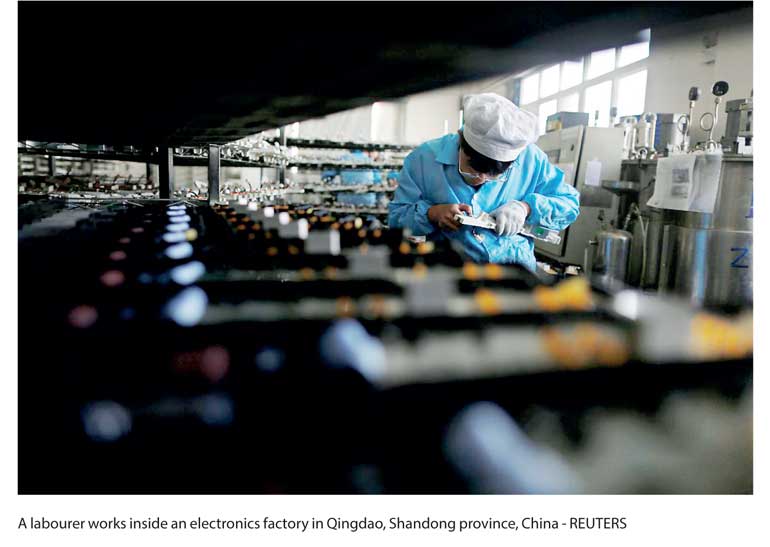Saturday Apr 26, 2025
Saturday Apr 26, 2025
Wednesday, 7 February 2018 00:00 - - {{hitsCtrl.values.hits}}
 HONG KONG (Reuters): Asia’s factories got off to a strong start in 2018, with manufacturing activity in many countries gaining momentum and hitting multi-year highs as global demand for hi-tech products remained strong.
HONG KONG (Reuters): Asia’s factories got off to a strong start in 2018, with manufacturing activity in many countries gaining momentum and hitting multi-year highs as global demand for hi-tech products remained strong.
Business surveys in Europe and the United States later on Thursday were also expected to show solid factory activity, reinforcing expectations of another year of synchronised global growth that has propelled stock markets to record highs.
Global policymakers are hoping that rosy scenario may finally translate into higher wages, spurring stronger domestic demand and inflation, which has been strangely absent from the recovery so far despite years of massive central bank monetary stimulus.
The Federal Reserve said on Wednesday that inflation was likely to pick up this year, bolstering expectations that US interest rates will continue to rise, while the Bank of England said price growth was back on the agenda.
But official inflation data in Asia has remained tepid, even as business surveys suggest companies are charging their customers more to recoup rising input costs.
South Korea on Thursday posted its lowest inflation rate in 17 months, and prices are growing less than expected in Australia and New Zealand.
“The pick-up in manufacturing activity does not necessarily have to reflect in domestic inflationary pressures as they include non-tradeable sectors,” said Trinh Nguyen, senior economist at Natixis in Hong Kong.
“(Asian) currencies have been strong, and there is still some weakness in domestic demand, particularly in the ageing east Asian countries such as Singapore and South Korea.”
Nguyen added this will make Asian central banks generally less aggressive than the Fed, with Malaysia and Philippines, where domestic demand has been strong due to pre-election spending in the former and accelerated infrastructure investment in the latter likely to lead the way in rate hikes.
In light of the subdued South Korean inflation data, ING economists cut their forecasts for rate hikes in that country this year to only one from two previously, and not until the fourth quarter.
Tech trade
The strongest manufacturing readings in Asia on Thursday came from tech exporters, which continue to ride a robust semiconductor cycle driven by upgrades in smartphones, industrial robots, cars, and, more recently, demand for computing machines used to mine cryptocurrencies like bitcoin.
In Japan, the Markit/Nikkei Purchasing Managers Index (PMI) rose to 54.8 in January, the highest in four years.
Taiwan’s reading rose to its highest since April 2011, while South Korean factory activity bounced back into expansion territory as domestic and export orders picked up. Levels above 50 suggest growth on a monthly basis.
Even in China – where authorities are cracking down on air pollution and excessive financial risks – factory growth last month appeared generally resilient, though economists agree the crackdowns will start to weigh on activity eventually.
The private Caixin/Markit PMI was steady at 51.5, matching December’s reading and better than economists at expected, though official data on Wednesday suggested a slight softening as export orders faltered.
A clearer picture of China’s manufacturing activity and its actual demand may not emerge until spring when winter smog restrictions are lifted and construction revives.
“Overall, we expect Asian manufacturing conditions to remain healthy, supported by robust external demand and accommodative domestic monetary policy,” said Krystal Tan, Asia economist at Capital Economics.
Risk of protectionism
However, the outlook for Asia’s export-reliant economies remains clouded by worries about US trade protectionism as the Trump administration starts translating last year’s tough talk into action.
Washington slapped steep import tariffs on washing machines and solar panels last week, drawing protests from Beijing and Seoul, and US officials suggest other measures are on the way.
While such steps could hurt growth, HSBC Private Banking’s head of investment strategy for Asia Cheuk Wan Fan said there was no reason to panic as Asian countries trade more with each other than in the past and are less reliant on the United States.
Individual companies were therefore more at risk than the wider economic picture.
“When we look at the risk arising from US protectionism and trade in-fighting, we adopt a bottom-up approach in identifying potential victims,” she said. “We will avoid these companies which heavily rely on US export markets.”
Discover Kapruka, the leading online shopping platform in Sri Lanka, where you can conveniently send Gifts and Flowers to your loved ones for any event including Valentine ’s Day. Explore a wide range of popular Shopping Categories on Kapruka, including Toys, Groceries, Electronics, Birthday Cakes, Fruits, Chocolates, Flower Bouquets, Clothing, Watches, Lingerie, Gift Sets and Jewellery. Also if you’re interested in selling with Kapruka, Partner Central by Kapruka is the best solution to start with. Moreover, through Kapruka Global Shop, you can also enjoy the convenience of purchasing products from renowned platforms like Amazon and eBay and have them delivered to Sri Lanka.
Discover Kapruka, the leading online shopping platform in Sri Lanka, where you can conveniently send Gifts and Flowers to your loved ones for any event including Valentine ’s Day. Explore a wide range of popular Shopping Categories on Kapruka, including Toys, Groceries, Electronics, Birthday Cakes, Fruits, Chocolates, Flower Bouquets, Clothing, Watches, Lingerie, Gift Sets and Jewellery. Also if you’re interested in selling with Kapruka, Partner Central by Kapruka is the best solution to start with. Moreover, through Kapruka Global Shop, you can also enjoy the convenience of purchasing products from renowned platforms like Amazon and eBay and have them delivered to Sri Lanka.